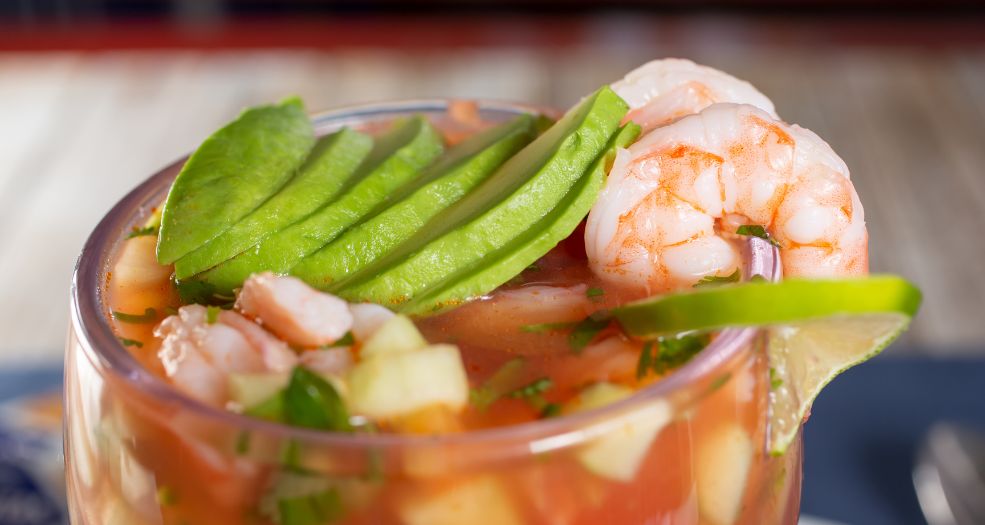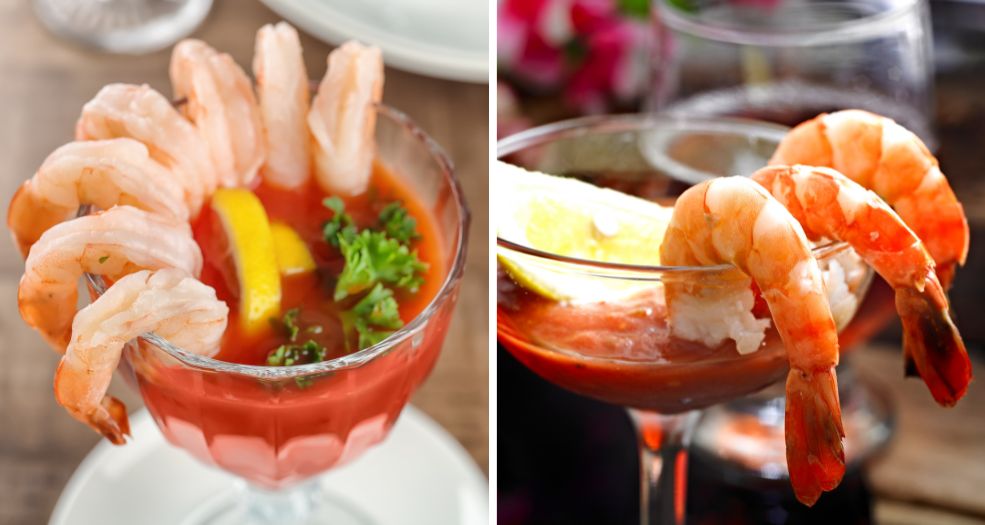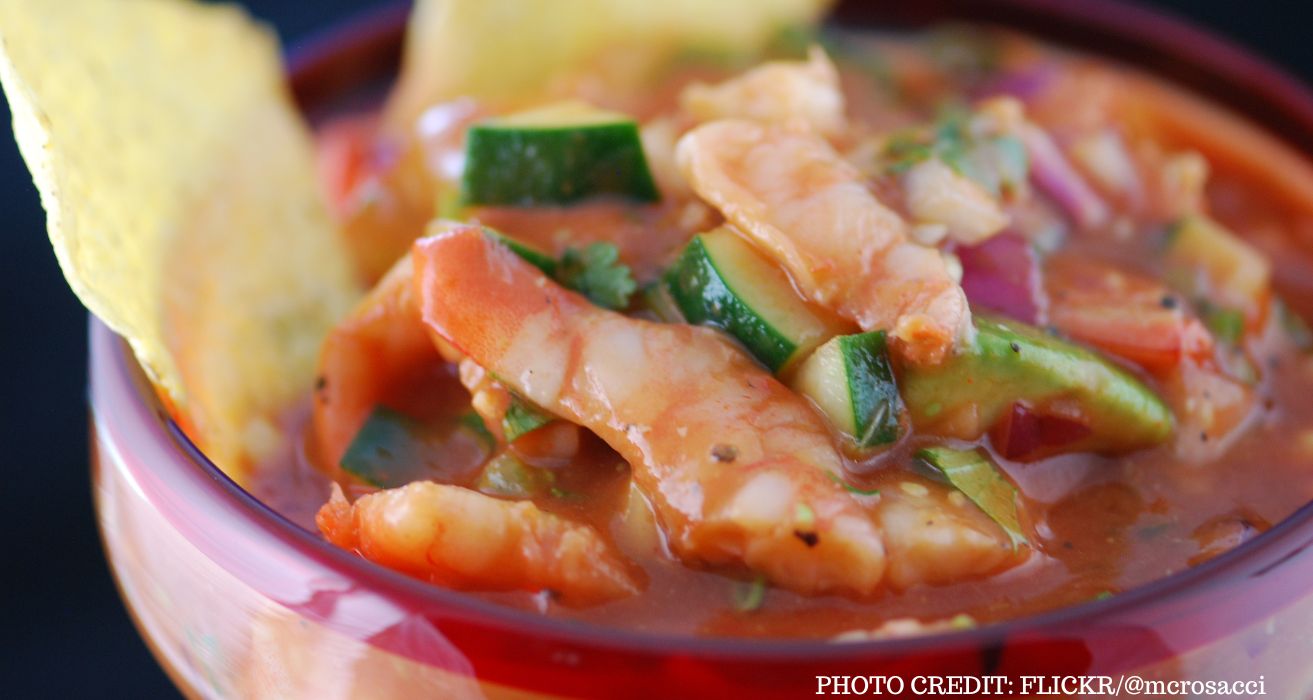In the vibrant tapestry of Mexican cuisine, a dish stands out not just for its flavors but also for its ability to bring people together: Campechana. This Mexican shrimp cocktail is a symphony of seafood, crisp vegetables, and a tangy, spicy tomato sauce that sings with each bite. More than just a recipe, Campechana embodies the spirit of communal dining and the rich culinary heritage of coastal Mexico. In this article, we’ll dive into the heart of Campechana, exploring its traditional recipes, cultural significance, and tips for making this delightful dish at home. So, let’s embark on this flavorful journey and discover why Campechana is more than just food—it’s a celebration of Mexican gastronomy.
Introduction
A Dive into the World of Mexican Shrimp Cocktail
At first glance, Campechana might seem like a simple shrimp cocktail, but it’s so much more. This dish is a cornerstone of Mexican coastal cuisine, a testament to the country’s love affair with seafood. Bursting with the flavors of freshly poached shrimp, ripe avocados, and a tangy tomato sauce, Campechana is a dish that’s as vibrant and lively as the regions from which it hails.
Historical Roots and Regional Twists
The origins of Campechana are as mixed and varied as the ingredients in its sauce. Believed to have originated from the coastal regions of Mexico, each area adds its unique spin to this beloved dish. From the traditional tomato and lime juice base to the addition of fiery chiles and creamy avocados, Campechana reflects the diversity of Mexican culinary traditions. Some regions prefer to add other seafood like octopus and crab, showcasing the bountiful harvests of Mexico’s waters.
Traditional Campechana Recipe
The Building Blocks of a Classic Campechana
Creating a classic Campechana starts with gathering fresh, high-quality ingredients. At its core, this dish is a celebration of the ocean’s bounty, featuring plump, juicy shrimp as the star. But what really sets Campechana apart is its vibrant sauce—a harmonious blend of tomato juice, lime juice, and a medley of fresh vegetables and herbs. Let’s dive into the essentials:
- Shrimp: 1 pound, medium or large, fresh and ready to be poached to perfection.
- Tomato Juice: 2 cups, forming the base of the flavorful sauce.
- Lime Juice: ¼ cup, adding a bright, citrusy kick.
- Onions and Cilantro: ½ cup each, finely chopped, infusing the dish with aromatic freshness.
- Avocado: 1 large, ripe, lending a creamy texture and rich flavor.
Crafting Your Campechana

Preparing the Shrimp
- Begin by poaching the shrimp in boiling water flavored with a hint of salt or your favorite seafood seasoning. This step ensures they’re cooked just right—tender and flavorful.
- Once cooked, cool the shrimp in ice water, then peel and chop them into bite-sized pieces, reserving a few whole ones for garnishing.
Mixing the Magic Sauce
- In a large bowl, combine the tomato and lime juices. This mixture forms the tangy base of your Campechana sauce.
- Add the chopped onions, cilantro, and other chosen vegetables like tomatoes, cucumbers, and jalapeños for a spicy kick.
- Fold in the chopped shrimp, letting the flavors meld together beautifully.
Finishing Touches
- Just before serving, gently fold in the diced avocado. Its creamy texture contrasts wonderfully with the crispness of the other ingredients.
- Serve your Campechana chilled, in clear glasses or bowls, garnished with whole shrimp and avocado slices.
Variations on a Theme
Every cook brings their own touch to Campechana, making it a versatile dish that invites creativity. Feel free to experiment with different seafood combinations or adjust the heat level with your choice of chiles. Some might add a splash of orange soda for a touch of sweetness, as noted in traditional recipes from coastal Mexico.
In crafting this dish, remember that Campechana is more than just its ingredients—it’s a dish meant to be shared. Whether you’re gathering around the table for a family meal or celebrating with friends, this Mexican shrimp cocktail is sure to delight everyone with its fresh flavors and vibrant presentation.
Cultural Significance and Occasions
Campechana: A Reflection of Mexican Coastal Cuisine
Campechana, with its rich tapestry of flavors and textures, is more than just a dish—it’s a vibrant celebration of Mexican coastal culture. This delightful shrimp cocktail mirrors the country’s vast shoreline, where seafood is not merely food but a way of life. Its ingredients—fresh shrimp, zesty lime juice, and ripe avocados—are staples of Mexican coastal regions, showcasing the bounty of the sea.
A Dish for Every Celebration
In Mexico, food is at the heart of every celebration, and Campechana is no exception. It’s a popular choice for festive occasions, from family gatherings to community fiestas. Its bright colors and refreshing taste make it a favored starter during the warm summer months, perfect for whetting the appetite for the main course to come. Moreover, Campechana’s versatility allows it to shine in both casual and formal settings, making it a beloved dish across all walks of life.
Sharing: The Essence of Campechana
At its core, Campechana is about sharing. Served in communal bowls or individual glasses, it invites everyone to dip in and enjoy the medley of flavors together. This aspect of sharing underscores the communal spirit of Mexican dining, where meals are a time for family and friends to come together, share stories, and create memories. Thus, Campechana is not just food; it’s an experience, a moment of connection shared over the love of good food.
Regional Variations: Celebrating Diversity
From the Pacific shores of Baja California to the Gulf of Mexico, every coastal region in Mexico has its own version of Campechana, each adding a local twist to this classic dish. Some might use a particular type of shrimp found only in their waters, while others might add local seafood like octopus or fish. These regional variations are a testament to the diversity of Mexican cuisine and the creativity of its people, who take pride in their local ingredients and culinary traditions.
In essence, Campechana is more than just a staple of Mexican seafood cuisine; it’s a symbol of the country’s rich culinary heritage, diverse ecosystems, and the communal spirit of its people. Whether enjoyed as a refreshing starter on a hot day or as the centerpiece of a festive meal, Campechana brings people together, celebrating the flavors of Mexico and the joy of shared experiences.
Serving and Presentation Tips
Elevating the Campechana Experience
When it comes to serving Campechana, presentation plays a crucial role in elevating the dining experience. This Mexican shrimp cocktail, with its vibrant colors and rich textures, offers ample opportunity for creative presentation. Let’s explore some tips to make your Campechana not only delicious but also visually stunning.

Choosing the Right Vessel
Traditionally, Campechana is served in tall or large glasses, such as schooner or martini glasses. This method not only showcases the layers and colors of the cocktail but also adds an element of elegance to your table setting. Consider using clear glassware to allow the bright colors of the shrimp, avocado, and tomato to shine through, creating an inviting display that beckons guests to dive in.
Garnishing with Flair
Garnishes are more than just decorative; they can enhance the flavor and appeal of the dish. For Campechana, consider adding:
- A wedge of lime on the rim of the glass for a pop of color and a hint of citrus.
- Whole shrimp hanging off the side of the glass, adding texture and an element of luxury.
- Fresh cilantro sprigs or avocado slices on top for a fresh, vibrant finish.
Accompaniments: The Perfect Pairings
While Campechana can certainly stand on its own, pairing it with the right accompaniments can elevate the dish even further. Offer a side of crispy tortilla chips for dipping, which adds a crunchy texture contrast to the smooth, rich sauce. Additionally, providing hot sauce on the side allows guests to adjust the heat to their liking, ensuring everyone can enjoy the dish exactly how they prefer it.
The Art of Assembly
To achieve a visually appealing presentation, layer your ingredients thoughtfully. Start with the sauce and shrimp mixture at the bottom, followed by diced avocados, ensuring they remain vibrant and green. Lastly, sprinkle the top with fresh cilantro or finely chopped onions for a burst of color and flavor right before serving. This layered approach not only looks impressive but also ensures each spoonful is a perfect blend of flavors and textures.
By focusing on the presentation and serving of Campechana, you turn a simple dish into an extraordinary culinary experience. Whether you’re hosting a casual family dinner or a formal gathering, these serving and presentation tips will surely impress your guests, making your Campechana the highlight of the meal.
Expert Tips for the Perfect Campechana
Crafting the perfect Campechana requires a blend of high-quality ingredients, timing, and technique. Here, we delve into expert tips that ensure your Mexican shrimp cocktail is not just good, but exceptional. These insights aim to enhance flavor, texture, and overall dining experience.
Selecting the Right Ingredients
The foundation of a memorable Campechana lies in the quality of its ingredients. Opt for fresh, wild-caught shrimp for their superior taste and texture. When it comes to avocados, choose ones that are ripe yet firm, ensuring they add creaminess without disintegrating into the sauce. For the tomato juice base, consider homemade or high-quality store-bought versions to avoid overpowering preservatives.
Balancing Flavors
The magic of Campechana is in its balance of spicy, tangy, and sweet flavors. Adjust the heat with the type and amount of chiles used. The tanginess should come from freshly squeezed lime juice, which also helps preserve the vibrant green of the avocados. A hint of sweetness can be achieved with a splash of orange soda, a secret ingredient that sets some regional variations apart.
Marinating for Depth
Allowing the shrimp to marinate in the lime and tomato juice mixture not only infuses them with flavor but also tenderizes them to perfection. A minimum of one hour is recommended, though longer marination times can deepen the taste profile. Be mindful not to overmarinate, as the acidity of the lime juice can begin to “cook” the shrimp further, potentially leading to a mushy texture.
Presentation Perfection
Assemble your Campechana close to serving time to maintain the freshness and texture of each component. Layer the ingredients thoughtfully for aesthetic appeal, ensuring each serving is bursting with color and flavor. Consider individual servings in clear glasses for a personal touch that elevates the dining experience.
Serving and Storage
Serve Campechana chilled, as it enhances the refreshing nature of the dish. If preparing ahead of time, keep the avocado and final garnishes separate until just before serving to preserve their texture and color. Properly stored in an airtight container, Campechana can be enjoyed for up to two days, making it a perfect make-ahead option for gatherings.
By following these expert tips, you can elevate your Campechana from a simple shrimp cocktail to a standout dish that captures the essence of Mexican coastal cuisine. It’s a testament to the joy of cooking with care, celebrating fresh ingredients, and sharing delicious meals with loved ones.
FAQs
What’s the difference between ceviche and campechana?
Ceviche and campechana offer distinct flavors and textures, catering to diverse palates. Ceviche, a popular dish in Latin America, primarily consists of raw fish marinated in citrus juices, notably lime, with added herbs and spices. Conversely, campechana, often found in Mexican cuisine, is a seafood cocktail featuring a mixture of cooked seafood such as shrimp, oysters, and sometimes octopus, served in a spicy tomato-based sauce. Therefore, the main difference lies in their preparation: ceviche highlights the acidity of the marinade to “cook” the fish, while campechana is a blend of cooked seafood.
Is campechana hot or cold?
Campechana is traditionally served cold. This chilled serving method enhances the refreshing qualities of the tomato-based sauce and cooked seafood, making it a perfect appetizer or snack, especially in warm weather.
What are campechanas made of?
Campechanas are made from a delightful mix of cooked seafood, including shrimp, oysters, and sometimes octopus or squid. These ingredients are combined in a tangy and spicy tomato-based sauce, often enriched with avocado, onion, cilantro, and lime juice, creating a harmonious blend of flavors.
What is the meaning of Campechana food?
Campechana food refers to a type of Mexican seafood cocktail. The term “campechana” is derived from the state of Campeche, Mexico, where seafood is abundant and such dishes are popular. It symbolizes a celebration of coastal cuisine, showcasing the fresh and vibrant flavors of the sea.
What is the history of Campechana?
The history of campechana is deeply rooted in the coastal regions of Mexico, particularly the state of Campeche. This dish evolved from the local tradition of combining freshly caught seafood with available native ingredients, such as tomatoes and chili peppers, creating a refreshing and flavorful seafood cocktail that reflects the region’s culinary heritage.
How many calories are there in campechana?
The calorie content in campechana can vary widely based on the specific ingredients and portion sizes. However, a standard serving typically contains between 200 to 400 calories, making it a relatively light option that’s rich in nutrients and flavor.
Can you eat shrimp cocktail hot?
While shrimp cocktail is traditionally served cold, there’s no rule against enjoying it hot. Some may prefer to gently warm the shrimp and sauce for a different taste experience, although this variation is less common.
How do you pronounce campechana?
Campechana is pronounced as “kam-peh-CHA-nah.” The accent falls on the third syllable, ensuring the name flows smoothly off the tongue.
What is Concha made of?
Concha is a type of Mexican sweet bread, characterized by its shell-like appearance. It’s made from a rich dough consisting of flour, sugar, eggs, and butter, topped with a crunchy sugar layer that’s often colored and flavored, creating a delightful texture contrast.
Is ceviche and sashimi the same thing?
Ceviche and sashimi are distinct dishes with different preparation methods. Ceviche, originating from Latin America, involves seafood marinated in citrus juices, while sashimi, a Japanese delicacy, consists of thinly sliced raw fish or meat, served without a marinade. The key difference lies in the marination process of ceviche, which “cooks” the seafood, as opposed to the completely raw presentation of sashimi.
What’s the difference between ceviche and aguachile?
Both ceviche and aguachile are Mexican seafood dishes, but they differ in flavor intensity and preparation. Ceviche features seafood cured in lime juice, often mixed with onions, cilantro, and peppers. Aguachile, translating to “chile water,” is spicier and involves a puree of lime juice, chili peppers, and water poured over raw shrimp or fish. Aguachile is known for its vibrant, fiery flavor, contrasting with ceviche’s milder acidity.
Are there different types of ceviche?
Indeed, there are numerous types of ceviche, varying by region and ingredients. Common variations include fish ceviche, often made with sea bass or tilapia, and mixed seafood ceviche, incorporating shrimp, octopus, and squid. Ingredients such as avocado, tomato, and various peppers can add unique flavors and textures, reflecting local culinary traditions.
What’s the difference between ceviche and coctel?
The primary difference between ceviche and coctel, such as a shrimp cocktail, lies in their preparation and presentation. Ceviche involves seafood cured in citrus juices, served with minimal liquid. Coctel, on the other hand, is a seafood dish served in a flavorful tomato-based sauce, often with avocado, cilantro, and onion. While both celebrate the fresh flavors of the sea, their textures and serving styles distinctively vary.
Can I Use Frozen Shrimp for Campechana?
Yes, you can use frozen shrimp for making Campechana. Ensure they’re thoroughly defrosted and dried before poaching. Fresh shrimp, however, tend to offer a better texture and flavor, crucial for the dish’s authenticity and taste.
How Long Can Campechana Be Stored in the Refrigerator?
Properly stored in an airtight container, Campechana can last up to 2 days in the refrigerator. It’s best enjoyed fresh, so try to prepare it close to serving time, especially after adding the avocado to maintain its color and texture.
Are There Non-Alcoholic Substitutes for Tequila in Campechana Recipes?
While some recipes feature tequila for an extra kick, it’s not essential for a traditional Campechana. You can simply omit it without a direct substitute, or use a splash of non-alcoholic beer or apple cider vinegar for an added depth of flavor without alcohol.
How Can I Make My Campechana Spicier or Milder?
Adjust the heat level in your Campechana by controlling the type and amount of chiles used. For a milder version, remove the seeds and veins from the chiles, or use bell peppers for a no-heat option. To turn up the heat, add more of your chosen chiles or incorporate a spicier variety, such as serranos or habaneros.
Is It Possible to Add Other Seafoods to Campechana?
Absolutely! Campechana is versatile and can include a variety of seafood. Common additions include lump crabmeat, octopus, or even oysters. The key is to ensure all seafood is cooked properly and marinated with the rest of the ingredients for a unified flavor profile.
These FAQs aim to clarify common queries regarding the preparation, customization, and storage of Campechana, ensuring everyone can enjoy this delightful dish regardless of their cooking experience or taste preferences.
